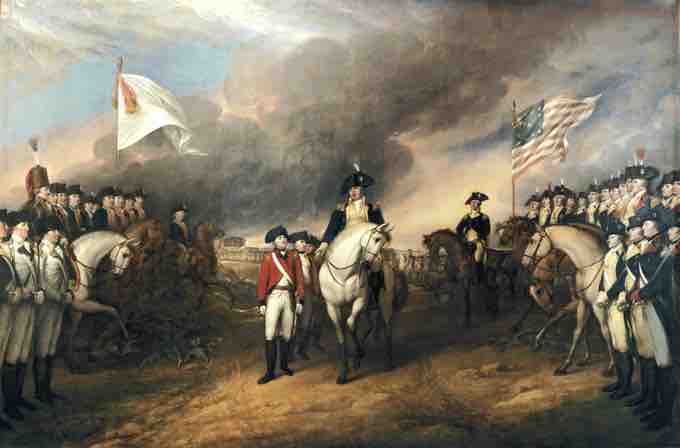Surrender at Yorktown
The culminating engagement of the Revolutionary War, the Siege of Yorktown, marked the end of British power in the colonies. The combined assault of American forces led by General George Washington and French forces led by the comte de Rochambeau resulted in a decisive victory over the British army forces commanded by Lieutenant General Lord Charles Cornwallis.
Initial Movements
On May 20, 1781, CCornwallis arrived at Petersburg, Virginia, with 1,500 men after suffering heavy casualties at the Battle of Guilford Courthouse. Cornwallis sent raiders into central Virginia, attacking depots and destroying supply convoys, in an attempt to cut off Continental supply lines. Cornwallis was shadowed by a force of 4,500 French forces under the command of the Marquis de Lafayette. British Commander-in-Chief Henry Clinton ordered Cornwallis first to Portsmouth and then to Yorktown, where he was instructed to build fortifications for a deep water port.
In 1780, over 5,000 French soldiers had landed in Rhode Island to support their American allies in operations against British-controlled New York City. In July 1781, Washington proposed a joint attack by Franco-Continental forces on the northern part of Manhattan Island, but was advised against this tactic by his comrades. Washington and French commander Rochambeau shifted attention to operations in Virginia upon receiving the support of French Lieutenant General comte de Grasse. In August 1781, in what has since become known as the Celebrated March, the combined armies of Washington and Rochambeau departed from New York to Virginia, engaging in tactics of deception to lead the British to believe a siege of New York was planned.
De Grasse sailed from the West Indies and arrived in the Chesapeake Bay in late August 1781. British Admiral Sir Thomas Graves led a fleet from New York to meet de Grasse but underestimated the strength of the French fleet. In early September, the British were defeated by de Grasse in the Battle of the Chesapeake and forced to fall back to New York. As a result of this victory, de Grasse established a naval blockade of Yorktown.
On September 14, Washington arrived in Williamsburg, Virginia, and the revolutionary allies' army and naval forces surrounded Cornwallis. Soon after, the allies built their first parallel (earthworks to support a siege) and began the bombardment of British forces. On September 26, transports with artillery, siege tools, and French infantry and assault troops arrived from the northern end of the Chesapeake Bay, giving Washington command of an army of 7,800 Frenchmen, 3,100 militia, and 8,000 Continentals. On September 28, Washington led the army out of Williamsburg to surround Yorktown.
Cornwallis initially relied on a chain of seven redoubts and batteries linked by earthworks along with batteries that covered the narrows of the York River at Gloucester Point. However, the British General soon pulled back from all of his outer defenses. While anticipating the arrival of a relief force of 5,000 men within one week, the British forces occupied three defenses: Fusilier's Redoubt on the west side of the town and Redoubts 9 and 10 in the east.
The Americans and the French took possession of the abandoned British defenses and began to establish their own batteries there. With the British outer defenses in their hands, allied engineers began to lay out positions for the artillery and Continental forces, improved their works, and deepened their trenches.
Washington fired the first gun on October 9. With the British defense weakened, Washington sent two columns to attack the last major remaining British outer defenses, on October 14, 1781. A French column took Redoubt 9 and an American column took Redoubt 10. Following these successes, the allies were able to complete their second parallel.
On October 16, Cornwallis made an unsuccessful attempt to evacuate his troops across the York River to Gloucester Point. With the American artillery closing in, the British situation began to deteriorate rapidly, and Cornwallis asked for terms of capitulation on the 17th. After two days of negotiation, Cornwallis surrendered 7,087 officers and enlisted men in Yorktown and a further 840 sailors from the British fleet in the York River to Washington and Rochambeau. Cornwallis did not attend the surrender ceremony, claiming illness.

Surrender of Lord Cornwallis
Depicting the British surrendering to French (left) and American (right) troops. Oil on canvas, by John Trumbull, 1820.
The Surrender of Lord Cornwallis at Yorktown
The articles of capitulation were signed on October 19, 1781. Signatories included Washington, Rochambeau, StJacques-Melchior Saint-Laurent, the comte de Barras (on behalf of the French Navy), Cornwallis, and Lieutenant Thomas Symonds, the senior Royal Navy officer present. Cornwallis' men were declared prisoners of war and promised good treatment in American camps. Officers were permitted to return home after taking their parole.